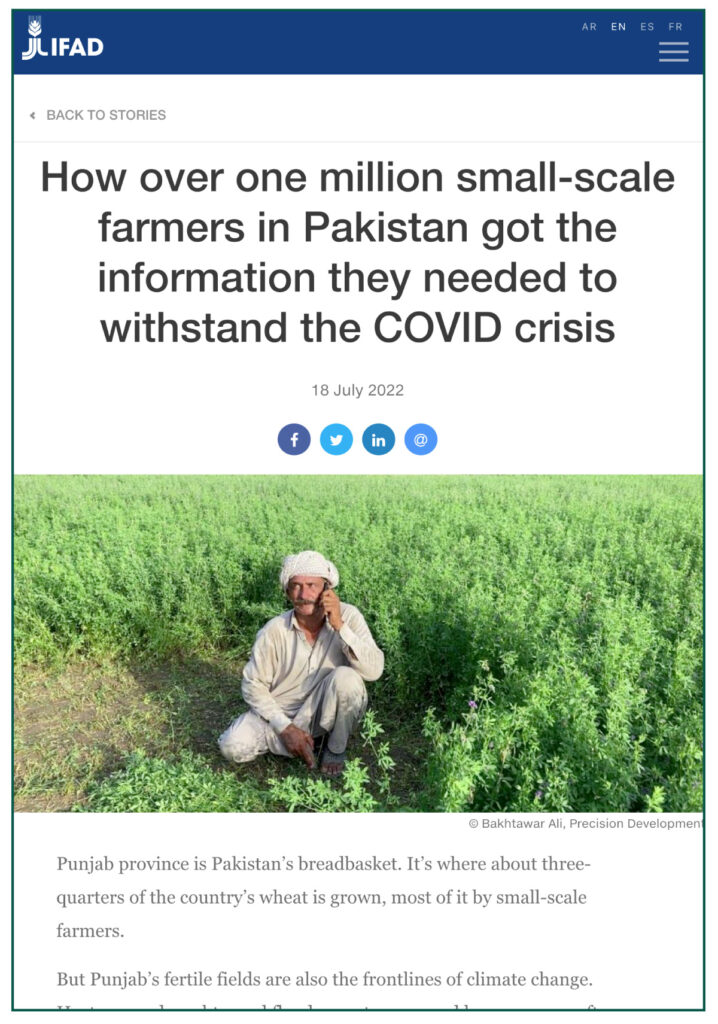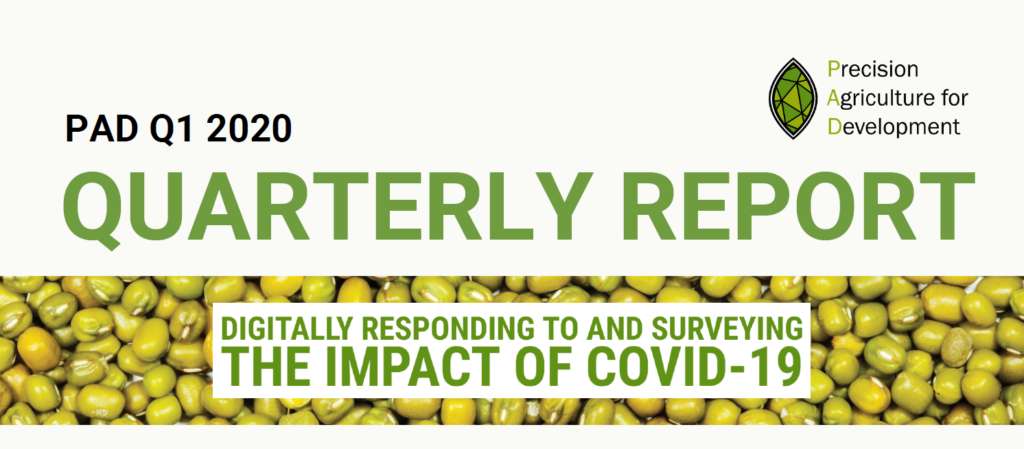Given existing poverty, dependence on agriculture for livelihoods, and lack of access to safety nets, poor smallholder families in low- and middle-income countries are particularly vulnerable to exogenous shocks. In March 2020, when the world shut down and told people to stay home to mitigate the public health impacts of COVID-19, many poor smallholder families were left reeling. In response to the growing humanitarian crisis, in April 2020 the International Fund for Agricultural Development (IFAD) launched a multi-donor COVID-19 Rural Poor Stimulus Facility (RPSF) to improve food security and resilience among poor rural people during the pandemic.
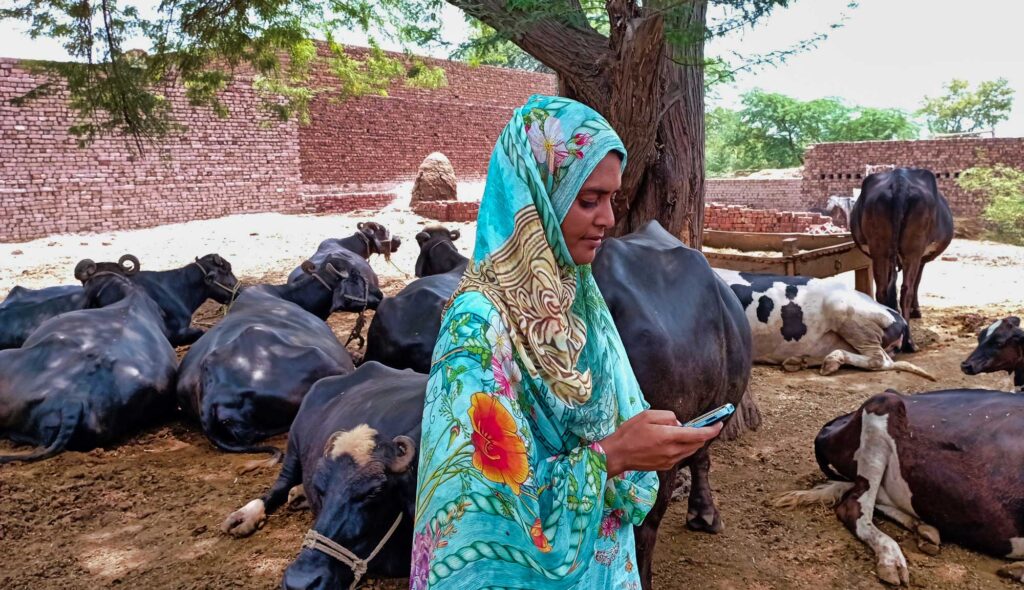
PxD was one of several RPSF grant recipients and interventions selected, all of which focused on either digital services, providing inputs or assets, access to markets, or targeting funds for rural financial services. In collaboration with the IFAD country teams and their government partners, PxD implemented three digital advisory services in Kenya, Nigeria, and Pakistan between August 2020 and September 2021 to provide digital extension services to approximately two million users. PxD reached 1.2 million farmers in Pakistan, 650,000 in Kenya, and 100,000 in Nigeria, surpassing the initiative’s target of 1.7 million farmers. This includes roughly 178,000 IFAD project beneficiaries across the three countries. These farmers received timely, relevant, and customized agricultural recommendations to improve their farm productivity directly via their mobile phones.
After successfully launching the initial digital services and delivering agricultural advice, IFAD and PxD conducted RPSF rapid assessments in late 2021 to assess farmer outcomes in all three countries. The surveys were designed to compare production, sales, income, food security, and resilience outcomes after the onset of COVID-19 but before the digital advisory intervention (the pre-intervention period) and after the intervention (the post-intervention period). We define resilience as the ability to cope with unexpected challenges and shocks, such as the ability to deal with drought/floods, pest invasions, and rising input prices. The final sample sizes for Kenya, Nigeria, and Pakistan were 400, 395, and 600, respectively. We stratified the samples by gender, youth status.Youth was defined as heads of households under 35, agro-ecological zone (AEZ) or state1Agro-ecological zones were used in Kenya and Pakistan; the survey covered seven (including unknown) and five AEZs, respectively. We stratified by seven states in Nigeria., and engagement level Kenya and Nigeria only, where we differentiate between high and low engaged users using the median number of messages or calls responded to. so we could analyze and compare outcomes by these subgroups. Within a country, we tested for statistical significance of crop, livestock, poultry, and agribusiness production and sales, as well as food security and income indicators between the pre-intervention and post-intervention period. The samples of farmers selected for the intervention and the surveys were randomly selected from our user bases of IFAD beneficiaries within each country, which may not be nationally representative. Moreover, this is a descriptive analysis, and we cannot infer whether PxD’s services had a causal impact on outcomes reported after the intervention because of the lack of an experimental design (there was no control group).
Farmer-reported outcomes during COVID-19, pre-intervention
Across all three countries, most respondents reported a loss or reduction in production, sales, number of meals, and resiliency during COVID-19 prior to PxD’s RPSF intervention (pre-intervention period). Respondents from Pakistan seemed to be the least affected by the onset of COVID-19, as fewer respondents reported reductions or losses, compared to Nigeria or Kenya. Moreover, almost half as many respondents reported reducing meals (37%) than in Kenya (67%) or Nigeria (69%). For all indicators except food security, respondents from Kenya reported the worst outcomes, including over 98% who reported lost or reduced production during COVID-19. There was also a wide disparity between the percentage of respondents reporting selling assets across the three countries. Almost two-thirds (65%) of respondents in Kenya reported selling assets because of COVID-19, whereas less than 10% of respondents in Nigeria reported the same.
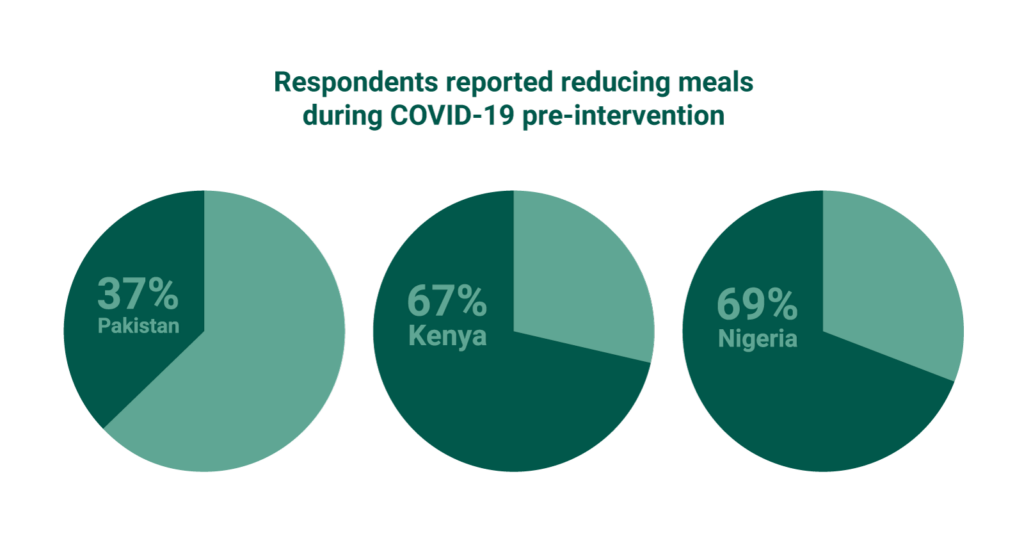
We also disaggregated production and sales outcomes by specific types of farming that farmers engage in, namely: crop growing, livestock rearing, poultry raising, and agribusiness activities. We find that agribusiness production and sales suffered the most in Pakistan when compared to crop, livestock, and poultry. This finding could be attributed to COVID-19 restrictions which limited the ability to engage in business activities. However, in Kenya and Nigeria, farmers reported larger reductions in crop production and sales compared to livestock, poultry, or agribusiness.
While respondents in Kenya overall seemed to fare the worst in the pre-intervention period, Kenyan women suffered disproportionately more. For example, all Kenyan women reported a reduction or loss of production during the pandemic, and women reported higher reductions than men for all other indicators. We don’t see the same clear pattern in Nigeria or Pakistan, although more women from all three countries reported worse food security outcomes than men. This could in part be due to cultural expectations of women eating last and in small portions, compared to men in the same household.
… and post-intervention
After the RPSF intervention concluded in late 2021, during a lull in the COVID-19 pandemic between the Delta and Omicron waves, we observed encouraging evidence of improved farmer resilience. Respondents in all three countries indicated that conditions had improved relative to the early phase of the pandemic, at the onset of COVID-19 but before the digital advisory intervention (the pre-intervention period), however, some fared better than others. For example, Nigerian respondents reported maintaining or improving production, sales, income, meals eaten, resilience, and asset indicators at higher rates than those in Kenya and Pakistan. Considering the poor conditions they reported during COVID-19, we take this as a sign that Nigerian respondents may have recovered from the pandemic more quickly than their counterparts in Kenya and Pakistan. Conversely, in addition to suffering the worst outcomes in the pre-intervention period, Kenyan respondents indicated that they maintained or improved outcomes the least in the post-intervention period. Only about half of Kenyan respondents reported production and meals were maintained or increased, and less than half reported maintaining or increasing sales, income, resiliency, and assets. Only 25.5% of Kenyan respondents reported income stayed the same or improved, highlighting that Kenyan farmers have struggled significantly in recovering from the pandemic, even after receiving the intervention.
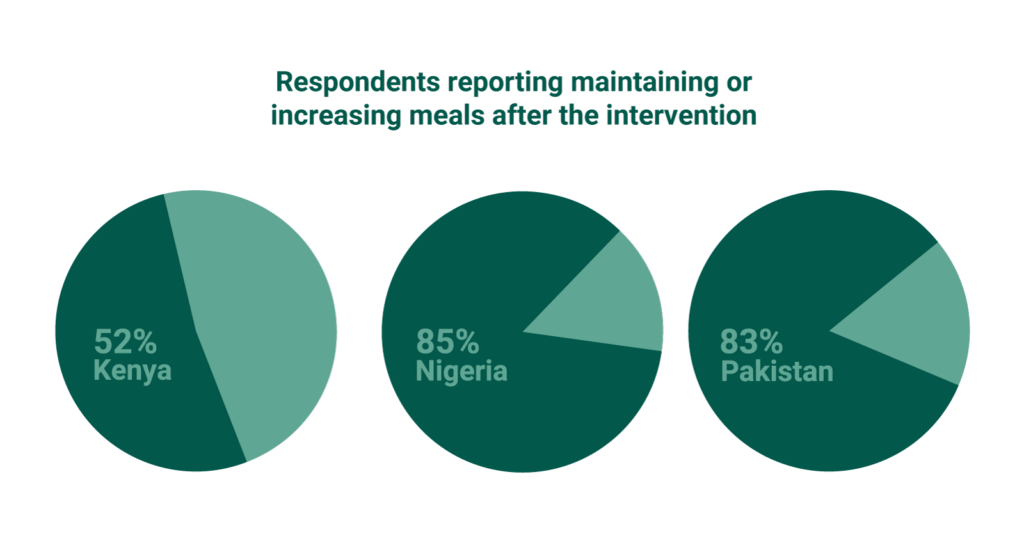
Kenya experienced severe drought during the long rains 2021 season (February-March to June-August depending on location) while the RPSF intervention was underway and during the collection of this data, which likely contributed to the poor outcomes reported after the RPSF intervention. For example, many farmers reported failed crops rendering it impossible to follow the customized digital advisory of the intervention, and to harvest and sell their crop. This is corroborated by reports estimating reduced crop production of up to 70% in Kenya during the drought2Oxfam International, 2022 https://www.oxfam.org/en/press-releases/many-28-million-people-across-east-africa-risk-extreme-hunger-if-rains-fail-again.
Disaggregating the results by type of farming activity, we find that Kenyan and Pakistani farmers reported production and sales reductions in agribusiness the most, even after the RPSF intervention. Because COVID-19 restrictions imposed by the government persisted during the intervention and survey period, we suspect that these restrictions played a role in farmers’ ability to engage in agribusiness, resulting in lower production and sales than other farm activities. In Nigeria in the post-intervention period, farmers reported reductions in production and sales for crop farming more than the other surveyed farm activities, suggesting that even though there were improvements to production and sales after the intervention, farmers’ crop yields suffered the most, relative to their livestock, poultry, and agribusiness activities.
In Pakistan, we observe better outcomes than in Kenya, although slightly less than half (48%) of respondents indicated they maintained or improved their income after RPSF, and only slightly more than half (57%) reported maintaining or improving their sales. Greater than expected wheat yields might have contributed to the better outcomes observed in Pakistan. But while these figures are somewhat encouraging and indicate that some Pakistani farmers were able to recover from COVID-19-related shocks, it also indicates that a significant share of farmers has not recovered. This could be because of the lingering effects of COVID-19 such as global trade shocks and new variants disrupting economic activity via additional lockdowns.
Similar to the outcomes reported during COVID-19, Kenyan women respondents indicated they maintained or improved outcomes less than their male counterparts after the intervention, across all indicators except assets. Only 17.3% of women reported maintaining or improving their income after RPSF, which is almost half the proportion for men, highlighting the predicament of women in Kenya in the face of COVID-19 and drought-related shocks. In Pakistan, while overall outcomes were better, we still note women reported maintaining or improving production, sales, income, and meals at lower rates than men. In Nigeria, a higher proportion of women actually reported maintaining or improving income, meals, and resiliency, and for the other indicators, women reported maintaining and improving at similar rates to Nigerian men. However, we also found evidence that women were disproportionately affected in the livestock sector; Nigerian women were more likely to report reductions in livestock production and sales after RPSF, compared to their male counterparts. Across all three countries, women reported faring worse than men in maintaining or increasing sales.
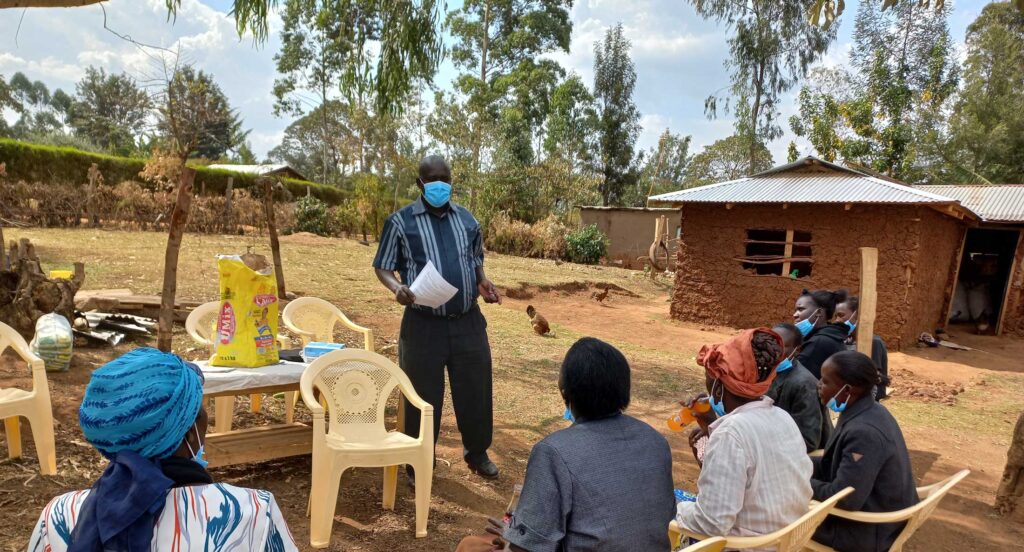
We also disaggregated the post-intervention RPSF results by farmers’ level of engagement with the PxD service, where we defined highly engaged users as having picked up or responded to more than the median number of calls (Nigeria) or SMS messages (Kenya)3We did not disaggregate by level of engagement in Pakistan.. In Kenya, we did not see any clear patterns by engagement level. However, in Nigeria, we found that highly engaged users (who picked up more than seven calls) reported maintaining or improving production, sales, and income at a higher rate than lower engaged users. This result provides suggestive evidence to our theory of change that users who more actively engage with our services may implement more of (or implement better) our recommendations, leading to improved outcomes.
It was challenging to draw clear conclusions from the data at the level of agro-ecological zone and state, due to the small number of respondents per zone or state. For example, in Kenya, there is some evidence that households from the upper highlands (UH) AEZ fared better than respondents in other zones. This may be because the UH zone was less affected by severe drought than other more arid regions in the country. In Nigeria, respondents in Katsina fared worse than the other states, reporting the highest level of reductions in most production, sales, food security, and resiliency measures. We suspect that local terrorism and banditry in the state played a role in the poor outcomes reported there. Meanwhile, respondents in the Nigerian state of Jigawa reported faring the best, which may be because widespread telecommunication shutdowns that plagued the country during the grant period were avoided, and the state is relatively peaceful compared to others in the north.
While the initial COVID-19 shock occurred in early 2020, the results of the surveys suggest that there are strong lingering negative effects in all three countries (as well as other severe shocks such as extreme weather events and terrorism) and more direct support is needed to return smallholder farmers to their pre-COVID-19 state. While this analysis does not estimate the causal impact of PxD services, we plan to use the data from this analysis to improve our services to more effectively meet farmers’ needs. In Kenya, we hope to specifically address weather-related shocks such as severe drought. Weather-related services are already being explored in Pakistan and India and learnings from these pilots might also be applicable in Kenya. Based on the evidence that women found it more difficult to cope and recover from COVID-19, we hope to develop women-targeted interventions designed to reach more women users or develop content tailored to women’s needs. This will build on gender-focused service experimentation we have undertaken such as providing messages with a female narrator and nudges encouraging spouses to share PxD advisory with each other, as well as implementation of advisories focused on female-dominated value chains such as kitchen gardens, dairy, and livestock.
Since the conclusion of the intervention and endline survey, farmers’ situations have become even direr. Experts warn of rising food shortages and hunger due to high global inflation and supply chain disruptions caused by the war in Ukraine. The World Bank estimates that the Agricultural Price Index is 14% higher as of this June compared to January and 94% of low-income countries are experiencing food price inflation greater than 5%. The already looming food crisis is expected to be exacerbated by a sharp increase in fertilizer prices, largely driven by the war in Ukraine, as Russia and its ally Belarus produce 40% of the world’s supply of potash, and Russia and Ukraine together export 28% of nitrogen and phosphorus-based fertilizers. Within this context and amid the backdrop of the ongoing pandemic, the need for strong support for poor smallholder families is urgent.
Our partner and funder, the International Fund for Agricultural Development (IFAD), has published a ‘story’ on their website about our collaboration to deliver much-needed digital information to Pakistani smallholder farming families to promote resilience during the COVID-19 pandemic.
We look forward to deepening our engagement with IFAD in the service of smallholder farmers in Pakistan, and beyond!
Read more about the initiatives we have implemented in partnership with IFAD :
Precision Development (PxD) leverages needs assessment research to inform our agricultural extension services, and we survey our farmers to gauge their opinion of our services. Sourcing information from farmers gives us direct insight into the challenges and opportunities farmers face. We use these insights to improve the design of our services and the content of our advisory messages in an effort to align them most closely to farmers’ informational needs.
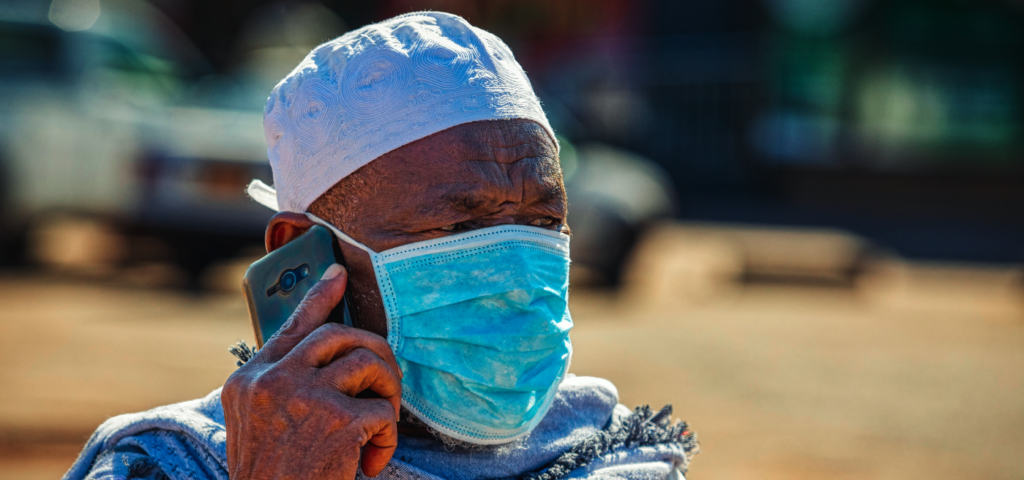
Through the course of 2021, as we designed and rolled out a new advisory service for farmers in Nigeria, we conducted five surveys to inform more evidence-based decision-making:
- Baseline survey (Jan 21)
- Dry season feedback survey (7th April)
- Wet season feedback survey (3rd August)
- Wet mid-season adoption and knowledge survey (20th August)
- End-line survey (December – analysis is ongoing)
Having a clear line of sight into the needs of farmers has been critical as the COVID-19 pandemic has evolved and created new and shifting challenges for farmers in remote areas.
At PxD we believe the information revolution and the spread of mobile technology to people living in poverty offer unprecedented opportunities for increasing access to information at scale and at a very low cost. We promote digital information-sharing systems to distribute quality, actionable and targeted information. By obtaining regular feedback from farmers through research in behavioral economics and social learning our services are improved to encourage the adoption and assimilation of practical information and improved or adapted production practices during the COVID-19 pandemic.
Gathering Insights on Farmers’ Needs
Utilizing an emergency grant from the International Fund for Agricultural Development (IFAD), PxD began working in Nigeria in November 2020 – eight months after the World Health Organization’s assessment of COVID-19 as a “pandemic”. PxD’s initial service, delivered during the dry season, reached more than 5,000 smallholder farmers within three months of the program’s launch. The service was then scaled to serve more than 100,000 users during Nigeria’s primary growing season, the wet season. PxD collaborated with the Federal Ministry of Agriculture and Rural Development (FMARD) to implement the Nigeria Rural Poor Stimulus Facility (RPSF), funded by the International Fund for Agricultural Development (IFAD). IFAD’s funding objective was to assist Nigeria to mitigate the impact of COVID-19 on smallholder farmers and its goal was to insulate domestic food supply by supporting access to affordable inputs and advisory to sustain production.
We believe that gathering baseline information from farmers about their needs was a critical factor that contributed to the success of PxD’s digital advisory service in Nigeria. We conducted a baseline survey in January 2021 to collect information on:
- Farmers’ socio-economic, demographic, and institutional characteristics;
- Their knowledge about dry season cultivation of crops and Good Agricultural Practices (GAPs); and
- Their perception of and willingness to receive mobile advisory services.
The survey interviewed 254 farmers randomly selected from a database of over 5,000 farmers. Findings from the baseline survey showed that 95% of the respondents indicated they would be interested in planting during the dry season. The remaining five percent identified lack of water and access to land as major barriers to engaging in any planting in the dry season. The survey also revealed that a lack of appropriate inputs, pests and disease problems, personal preferences, bad harvests, distance from water, and knowledge gaps are important challenges for the smallholder farmers.
Listening to the Farmers from the ‘Get-go’!
At PxD, we prioritize offering our users valuable and practical information to change or improve farmer behaviors and farm productivity. We do this by providing information customized – wherever possible – to a farmer’s location, market conditions, and personal characteristics. To calibrate our systems effectively, it is essential that we hear from the farmers themselves to understand their needs as they relate to their socio-economic realities. The results of our dry season baseline survey provided useful insights about farmers’ crop choices as well as their previous or existing crop practices. This information was vital for informing our product development and service delivery.
Only 56% of farmers surveyed during our baseline assessment had ever attended any training or workshops on crop production techniques. The survey also revealed that rice was the preferred crop for the dry season, followed by onions, tomatoes, and other vegetable crops. These and other findings helped us develop recommendations for specific topics, crop value chains, and farmer groups.
While just over half of farmers surveyed at baseline had experienced some kind of extension outreach, the advisory content received varied. For example, fewer than 50% of farmers had received training on GAPs such as:
- Weed management;
- Harvest and postharvest handling;
- Water management;
- Nursery establishment;
- Transplanting; and
- Input selection.
Whereas more than 50% had received training on:
- Pest and disease management;
- Fertilizer application; and
- Land preparation.
Importantly, the team also learned that fewer than 50% of the respondents had applied any of the GAPs or any other training they had received.
Monitoring Farmers’ Engagement and Feedback
One crucial aspect of our work at PxD is to gather evidence on the impact of our services on smallholder farmers. We are a learning organization that rigorously tests our services through experimentation and research. We have a high level of flexibility to adapt to the complexities of the various geographies where we work. Regular monitoring and evaluation of our interventions help us understand how our services are impacting our users and give us early insights into potential problems. PxD incorporates insights from behavioral economics, human-centered design, and social learning theory, and uses A/B testing and data science to identify what types of information and delivery mechanisms work best for our users.
In Nigeria, a feedback survey was conducted at the end of the 2021 dry season to assess farmers’ perceptions and use of the push call services, and to analyze factors that influenced their engagement with the service. The sample comprised 700 farmers randomly drawn from the seven states where the service was provided (Borno, Jigawa, Katsina, Kebbi, Sokoto, Yobe, and Zamfara). The sample distribution was 500 farmers from the ‘high participation’ group (with a more than 50% average listening rate) and 200 farmers from the ‘low participation’ group (with a less than 50% average listening rate). The survey results indicated that 88% of respondents, or a member of their family, recalled listening to any of the push call messages, while 86% reported “continuing to listen” to the calls (a proxy for continued engagement). This was particularly significant as it was the first season of the PxD program in West Africa.
Furthermore, a knowledge and adoption survey conducted in August, during the wet season campaign, indicated that 85% of respondents reported adopting at least one GAP, while 95% of respondents correctly answered one or more of the five knowledge questions asked in the survey. The survey also measured service satisfaction. Analysis of the survey results revealed a positive net promoter score of 39 (on a scale of -100 to 100), indicating that a majority of respondents (53%) said that they were likely to promote the service to other users, while only 14% of the sample reported being unlikely to recommend it or continue using the service.
To achieve behavioral change, the information conveyed should be accessible and of practical use to rural farmers. Ninety-four percent of respondents to the wet season feedback survey answered ‘Yes’ when asked: Were the messages clear and loud enough so that you could understand their content? In addition, 96% confirmed that they or a household member adopted the agronomic advice during the planting season.
Research shows that access to extension services is a key driver of technology adoption. Farmers are usually informed about new technology and its effective use by extension agents (Genius et al., 2010). Furthermore, the extension agents form a link between the researchers and users of the information, which helps to reduce transaction costs incurred when passing on the information about the new technology to a large heterogeneous population of farmers (Genius et al., 2010).
However, in-person extension services are expensive and time-consuming to deliver, and very difficult to scale. One can’t copy-and-paste trained extension agents, or their means of transportation, or guarantee that when extension agents make contact with a farmer the information they carry with them will be temporally valuable or practical. As evidenced by feedback from our farmers, very few Nigerian smallholder farmers have benefitted from extension services in the past. Feedback from farmers suggests that PxD’s model of digital agricultural extension in Nigeria, implemented in collaboration with partner organizations to maximize scale and at very low costs per farmer served1 Our Nigeria service was delivered at an average annual cost of $3.45 per farmer served, which compares extremely favorably with the costs of in-person extension services. With further scaling, we expect this number would fall further, and more closely align with PxD’s average cost per user served which at the time of writing was $1.61 per user per year., was considered by farmers to be valuable and relevant. Many farmers reported implementing the advice we broadcast to them. Digital delivery channels meant that we were able to deliver extension services under pandemic conditions when human movement and personal interactions were limited or prohibited.
The success and rapid scaling of our Nigeria service were built on strong partnerships, a portable and customizable in–house technology platform, and a service delivery model that we constantly update with information sourced from the farmers we serve, the results of surveys and experimentation, and rigorous evidence on the impact of our work. We look forward to building on our Nigerian successes and further assisting farmers in need as they confront wide-ranging challenges in very difficult conditions.
Acknowledgement
We would like to acknowledge the RPSF financial support of IFAD. Many thanks to the Nigerian team for their collective effort in drafting this post, and Emmanuel Bakirdjian, Theresa Solenski, Moira Levy, and Jonathan Faull for their contributions.
References
Balana B.B., Oyeyemi M.A., Ogunniyi A.I., Fasoranti A., Edeh H., Aiki J., and Andam K.S. (2020). The effects of COVID-19 policies on livelihoods and food security of smallholder farm households in Nigeria: Descriptive results from a phone survey. IFPRI Discussion Paper 1979. Washington, DC: International Food Policy Research Institute (IFPRI). https://doi.org/10.2499/p15738coll2.134179
Mungai L.M., Snapp S., Messina J.P., Chikowo R., Smith A., Anders E., Richardson R.B., and Li G. (2016). Smallholder Farms and the Potential for Sustainable Intensification. Front. Plant Sci. 7:1720. https://doi.org/10.3389/fpls.2016.01720
Paul A. Francis, John T. Milimo, Chosani A. Njobvu, and Stephen P. M. Tembo (2013). Listening to Farmers. Participatory Assessment of Policy Reform in Zambia’s Agriculture Sector. https://doi.org/10.1596/0-8213-4025-5
Genius, M., Koundouri, M., Nauges, C., and Tzouvelekas, V. (2010). Information Transmission in Irrigation Technology Adoption and Diffusion: Social Learning, Extension Services and Spatial Effects. https://doi.org/10.1093/ajae/aat054
Since August 2020, PAD has collaborated with the International Fund for Agricultural Development (IFAD), a UN affiliated multilateral agency, to deliver digital advisory to assist smallholder farmers in Kenya, Nigeria and Pakistan to boost productivity and resiliency as they navigate the evolving impacts of the COVID-19 pandemic.
On 05 May 2021, IFAD convened an #IFADinnovationtalk webinar to showcase our partnership under the auspices of presentations and a panel discussion entitled ‘Digital Agriculture and the Rural Poor: Challenges and opportunities in delivering results’. Keynote speeches were delivered by Michael Kremer, PAD co-founder and Nobel Prize winner, and Owen Barder, PAD CEO. Our colleague Uzoamaka Ugochukwu, Nigeria Country Launch Manager, participated in a panel with Vivian Hoffman (a PAD research partner at IFPRI) and Dr. Zahoor-ul-Hassan (a key champion of our work in the Government of Punjab, Pakistan), and Patrick Habamenshi (country manager of IFAD Nigeria).
As Owen Barder, PAD’s CEO, stated in his keynote address, our collaboration with IFAD has demonstrated:
First, that our services can be replicated, adapted and scaled in new geographies, and can be scaled up to new target populations in existing geographies;
Second, that we have been able to develop and deploy surveys and A/B tests to quickly and accurately gather and analyze information from users to improve our services and adapt to evolving challenges in near real time; and
Third, the combined capabilities of governments, multilateral organizations and non-profit service delivery organizations can deploy services quickly and at scale, using local talent and shared knowledge and systems.
The full text of Michael Kremer’s contribution is accessible here; Owen Barder’s speech can be accessed here; and a full recording of their presentations, panel discussion and subsequent Q&A is accessible via the video posted at the top of this page.
We envisage this our partnership with IFAD as both a mechanism for recovery from the devastating effects that the COVID-19 pandemic has had on smallholder farmers, and an investment in better ways of delivering agricultural information in the long term.
We are excited at our progress in advancing our systems to complement IFAD’s work in support of poor rural farming families and look forward to further success as we continue to work together to service poor, rural families with valuable and productive information.
Owen Barder, CEO
Sam Strimling, a Research Associate on PAD’s Kenya team, reflects on the results of a third round of interviews surveying farmers and agro-dealers across Kenya’s agricultural heartland.
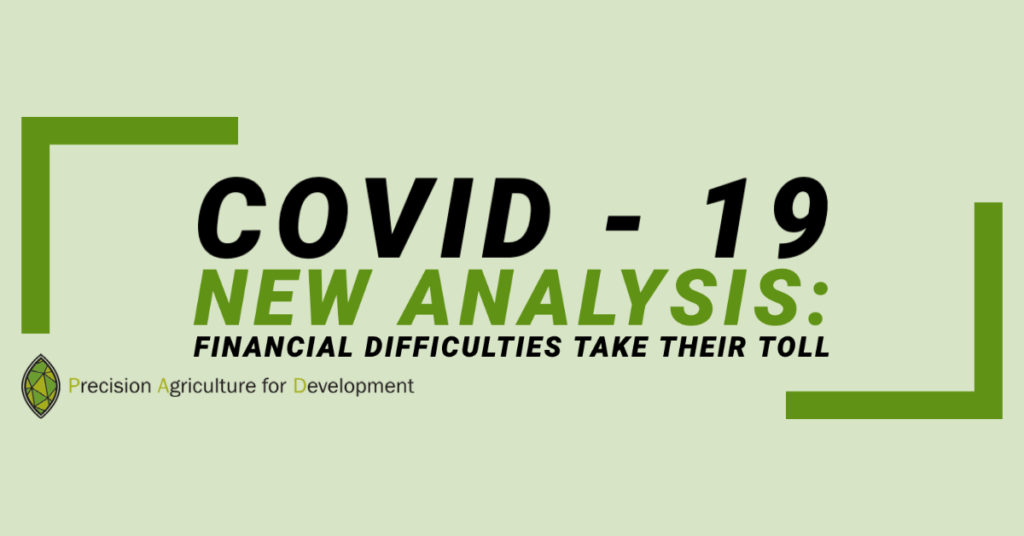
CONTEXT
In December 2020, Precision Agriculture for Development (PAD) interviewed 509 crop farmers and 274 agro-dealers registered on the MoA-INFO SMS platform in Kenya. This survey was the third and final round of a panel survey, of which the first round took place between late April and early June 2020, and the second took place from August to early September 2020.The first two rounds of surveys focused on the long rainy season, which is the main agricultural season in Kenya, and the third round examined the short rainy season. Data from all three survey rounds are visualized on our COVID-19 Dashboards.
During the survey period, COVID-19 continued to spread globally and in Kenya. Since the first reported case in Kenya on March 13, according to statistics collated by the World Health Organization, as of February 2, 2021, there have been 100,773 confirmed cases in Kenya, and 1,763 COVID-related deaths.
By the time of the survey, restrictions to mobility and social interaction that had been imposed in March and April in an effort to slow the spread of the virus had been relaxed: A nightly 7pm-5am curfew, first imposed on March 27, was revised to 9pm-4am on June 7. On April 6, a lockdown was imposed on Nairobi, which eventually covered five counties (Nairobi, Mombasa, Kilifi, Kwale, and Mandera). As of July 7, restrictions on movement other than curfew were lifted. Domestic flights also resumed on July 15, and international flights resumed August 1.
SAMPLE CHARACTERISTICS
In order to track the evolving economic and social effects of COVID-19 with the same population over time, across all rounds, we interviewed 1,471 farmers and 735 agro-dealers.
While individual respondents differed slightly across the three survey rounds, the demographics of the survey group remained similar. The below charts summarize select demographic information for both the farmer and agro-dealer surveys:
| Round | Total respondents | Counties represented | % male | Avg. age | % who grew maize as their primary crop |
| Round 1 | 973 | 44 | 58% | 41 | 79% |
| Round 2 | 974 | 44 | 57% | 42 | 80% |
| Round 3 | 509 | 42 | 56% | 44 | 53% |
The major difference in the farmer demographics across rounds is the percentage of farmers growing maize as a primary crop. It appears a large share of farmers grew beans rather than maize in R3, with 17% of R3 respondents reporting beans as their primary crop — up from 4% in R2. This makes sense in light of the larger seasonal context: farmers tend to focus on maize production during the long rainy season but diversify their crops during the short rainy season.
| Round | Total respondents | Counties represented | % male | Avg. age | Avg. annual sales (2019) | Avg. number of employees |
| Round 1 | 483 | 40 | 68% | 46 | US$11,351 | 2.2 |
| Round 2 | 427 | 40 | 72% | 45 | US$11,348 | 1.8 |
| Round 3 | 274 | 35 | 71% | 46 | US$10,564 | 1.5 |
In an effort to build a panel dataset to track change over time, we prioritized contacting farmers who had participated in our earlier surveys. Respondents who participated in R1 and/or R2 were prioritized; all R1 and R2 respondents were called three times before new respondents were called. Of the farmers interviewed in Round Three (R3), 70% participated in Round Two (R2) and 53% participated in Round One (R1). Of the agro-dealers interviewed in R3, 57% participated in R2 and 55% participated in R1.
FINDINGS
Farmers’ expectations for the previous (2020 long rainy) season were not been met, and farmers anticipated difficulties in purchasing sufficient inputs for the upcoming (2020 short rainy) season
Fifty-eight percent of R3 farmers reported a lower yield relative to the 2019 long rainy season, belying expectations expressed in R2 and R1 when 49% and 52% of farmers, respectively, said they expected a larger harvest relative to the previous year due to good rains and, reportedly, improved farming practices. The reasons cited by farmers in R3 for lower observed harvest were varied: 29% of farmers with a lower observed harvest in the 2020 long rainy season attributed this to excessive rains, with another 24% citing insufficient rain. Additionally, 24% explained that they had used fewer inputs. This makes sense given that 76% of R2 farmers anticipated difficulties purchasing sufficient inputs for the impending short rainy agricultural season, with 66% reporting they did not have enough money to do so.
Furthermore, of the 42% of R3 farmers who had sold all or some of their harvest from the long rainy season, 58% reported receiving a lower price versus the previous year. This again conflicted with the expectations of R2 and R1 farmers, of whom 58% and 66%, respectively, reportedly expected a higher price compared to the 2019 long rainy seasons. The primary perceived cause for dashed expectations appeared to be supply outstripping demand, with R3 farmers who received a lower price for harvest sold citing both higher market supply (43%) and fewer buyers (34%).
Still, expectations for the upcoming short rainy season were much more mixed, with 42% of farmers anticipating a lower harvest and 39% anticipating a higher harvest. These expectations in turn depended on those about rainfall: both the plurality of farmers who expected low harvests, as well as those expecting large harvests, cited rainfall as justification for these expectations. Price expectations in turn depended on expectations about supply: of the 54% of farmers who reported expecting a higher price for their forthcoming harvest, 60% attributed this to low production/market supply. Similarly, of the 31% of farmers reportedly expecting a lower selling price, 60% attributed this expectation to high production/market supply.
However, 80% of R3 farmers anticipated difficulties purchasing inputs for the 2021 long rainy season, a concern 62% attributed to lack of resources. In this way, R3 expectations were a continuation of earlier trends. Agro-dealers confirmed that prices were higher, with 62% of those interviewed in R3 reporting they had increased the prices charged to farmers relative to the same season previous year. This, too, was in line with earlier rounds: 65% of agro-dealers surveyed in R1 and 55% of those surveyed in R2 reported year-on-year price increases for the same set of inputs. However, with agro-dealers facing financial troubles themselves, the only way to stay in business may be through the practice of passing on high prices from suppliers, which have also increased according to 71% of agro-dealers interviewed in R3. Across all rounds, agro-dealers were statistically more likely (at the 1% level) to report charging farmers higher prices if the prices charged to them by suppliers had increased. Farmers’ inability to secure the necessary inputs may in part account for low harvest (and, consequently, high sale price) expectations for the season.
That said, agro-dealers are optimistic about their ability to satisfy the needs of the farmers who did attempt to buy from them: only 8% of R3 agro-dealers anticipated that they would be unable to meet farmer demand, compared with 26% in R2 and 29% in R1. The largest concern — cited by 71% of those in R3 who predicted they would be unable to meet farmer demand — was having insufficient resources to do so.
Continued food shortages and financial distress, relative to 2019
On a positive note, farmers experienced improved household consumption patterns compared to previous rounds, as they adapted to changing circumstances and as restrictions on mobility were lifted. Additionally, some of the improvement in consumption may be due to seasonal changes, as 42% of R3 farmers reported selling at least some of their seasonal harvest from the long rainy season, which means they likely have more cash on hand for household purchases. In R3, 62% of farmers reported difficulties buying food due to market changes over the past week – down from 71% of farmers in R2 and 87% in R1. Additionally, only 28% of farmers reported difficulty accessing markets over the past week due to mobility restrictions. This is just under half of the number who reported this issue in R2 (44%), which was in turn down versus 48% in R1. In further good news, over the past week, significantly fewer farmers in R3 reported reducing the number or size of household meals, reducing the amount of food purchased due to reduced income, and changing their diet composition. (Refer to the table below for the relevant statistics.)
That said, farmers still experienced significant distress compared to before the pandemic. In December 2019, just 8% R3 respondents reported difficulties buying food due to market changes, 5% reported mobility restrictions, 18% reported difficulties purchasing food due to reduced income, 16% reported reducing the size and/or number of meals, and 16% reported changing their diet composition.
| Experience | Dec. 2019 | May 2020 (R1) | Aug. 2020 (R2) | Dec. 2020(R3) |
| Difficulty purchasing food due to market changes | 8% of respondents | 57% of respondents | 47% of respondents | 21% of respondents |
| Difficulty going to the market due to mobility restrictions | 5% | 48% | 44% | 28% |
| Difficulty purchasing food due to reduced income | 18% | 63% | 70% | 51% |
| Reduced number and/or size of meals | 16% | 46% | 62% | 49% |
| Changed composition of meals | 17% | NA | 65% | 53% |
Business as (new) usual?
In an effort to adapt to changing circumstances, agro-dealers across all three rounds made changes to stocking, sales, and operations. Compared with R1 agro-dealers, R2 agro-dealers were statistically more likely to make changes across all three categories, and R3 agro-dealers were statistically more likely to make changes to sales and operations versus R2 agro-dealers. They were also slightly more likely to report making changes in stock, although this result was not statistically significant. (Refer to the below table for the relevant statistics.) These trends suggest changes to the business were imperative for long-term survival.
However, while agro-dealers may have reached a new normal in their stocking practices, sales, and operations, business has not returned to pre-pandemic levels. Instead, agro-dealers face serious economic headwinds and a difficult business environment. R3 agro-dealers were statistically more likely than R2 agro-dealers to report lower expected footfall, lower observed sales, and lower expected sales. Fifty-four percent of R3 agro-dealers who observed low footfall attributed this to insufficient resources and the same proportion gave the same reason for low sales. At this stage, respondents perceived the prolonged economic slowdown to present a larger obstacle than government-imposed restrictions or public health precautions.
| Experience | Round 1 | Round 2 | Round 3 |
| Stock changes | 31% of agro-dealers | 53% of agro-dealers | 56% of agro-dealers |
| Sales changes | 29% | 54% | 77% |
| Operations changes | 63% | 71% | 86% |
Specifically, in Round 3, 25% of all respondents reported reducing stock and 22% reported and implementing cashless/electronic transactions with their suppliers as a means of coping with the pandemic. Thirty-five percent of agro-dealers also reported implementing cashless/electronic transactions with farmer-customers. The largest changes to sales, however, were increased hygiene measures (handwashing stations, wearing gloves, etc.), undertaken by 51% of agro-dealers, and social distancing, performed by 39% of agro-dealers. Similarly, 62% of agro-dealers reported encouraging handwashing and 51% reported enforcing social distancing as key changes to operations. With the increasing implementation of these measures — and the relaxation of the nationwide curfew and mobility restrictions — agro-dealers were able to resume their pre-pandemic shop hours in R2 and continue through R3.
Additionally, as farmers adapted to the changing conditions, initially differential reactions by gender appear to have converged. In R1, female crop farmers were statistically more likely than their male counterparts to report that household members were spending fewer days on their own farms and paying higher prices for fertilizer (relative to the previous year); this was not the case in R2. However, in both R1 and R2, female crop farmers were significantly more likely than their male counterparts to report that they had had to rely on assistance from family to cover living expenses and were more likely to report having to reduce the size or number of meals served in the 30 days prior to being surveyed. Yet, by R3, there were no statistically significant differences by gender in measurements of production or consumption.
RECOMMENDATIONS
In R3, we asked farmers and agro-dealers directly which interventions or services could help them adjust to ongoing changes in the business environment associated with the pandemic. The purpose of this question was to inform program design not only for PAD, but also for other NGOs, government actors, and other stakeholders in the development community at large.
Our recommendations, informed by respondents’ preferences, fall into three buckets:
- Direct and indirect financial assistance: Unsurprisingly, given the reportedly difficult business environment, 18% of agro-dealers requested direct financial assistance and an additional 16% requested help acquiring inputs affordably. Similarly, 19% of farmers asked for provision of inputs, or requested particular inputs.
- Targeted advisory messages: Both agro-dealers and suppliers expressed a need for additional information. Twenty percent of farmers and 9% percent of agro-dealers requested general farming information, with an additional 7% of agro-dealers requested public health information. More specifically, when farmers were asked to rank proposed interventions pre-selected by PAD for their feasibility and mission alignment, many seemed eager to make the most of their limited funds: 31% chose as their first choice “information on soil testing,” while 27% ranked recommendations on less capital-intensive practices as a first priority.
- Improved market linkages: The plurality of agro-dealers (34%) ranked first “more information from farmers about input preferences,” suggesting a desire to improve market linkages. Along the same lines, the vast majority (96%) indicated they would be willing to share their contact information with interested farmers. Additionally, 91% of agro-dealers expressed a willingness to switch suppliers if a better price was offered. Given the trickle-down effect of supplier prices on the entire supply chain, providing agro-dealers with information and/or communication channels needed to improve their sourcing would help them stay in business while enabling them to meet farmers’ needs.
This research was funded by the COVID-19 Adaptation Fund, a joint initiative between the Global Development Incubator (GDI) and Instiglio. The aim of the Adaptation Fund is to collect data and find innovative solutions for service providers like PAD that serve vulnerable populations disproportionately impacted — socially and economically — by COVID-19.
Incorporating new survey data, and new visualizations, Dashboard 2.0 allows one to observe and compare trends across rounds of surveys and geographies.
Andrew Wang, a PAD summer research associate on the global research team, who was the primary creator of the new dashboard, writes:

The next iteration of our COVID-19 dashboard is here!
Dashboard 2.0 includes new survey data collected between mid-June and September 2020 in Kenya and two states in India. The new data complements, and is comparable with, Round 1 data collected in Kenya and one state in India in April and June. The updated dashboard also includes a new set of visualizations to illustrate temporal trends over the course of the pandemic.
Building on the first round of surveys in Kenya and State 1 in India, our team conducted a second round of surveys (R2) in Kenya between July and August, and in India between June and September. The updated dashboard also includes data from a round of surveys conducted in a second state in India (State 2) between May and July. Across all three regions, a total of 4,166 farmers, of whom 1,070 (25.7%) were women farmers, were surveyed and their responses are included in this updated dashboard. A third round of data collection is planned in Kenya and State 1 in India, and the dashboard will be updated in due course.
While specific trends differ between, and within, countries, there are several notable findings from the new visualizations. It should be noted that these trends are observational and that, on the basis of these survey results alone, cannot be causally attributed to COVID-19.
- Disruptions to labor markets in India appear to have lessened over the course of the pandemic as the Kharif (summer) cropping season got underway and lockdown restrictions eased. In August and September, over 70% of surveyed farmers in State 1 reported hiring at least as much labor as last year, compared to only 50% in May and June.
- However, measures of reported food insecurity rose throughout the summer in India, with over 60% of respondents reporting that they were unable to buy the amount of food their household usually consumed due to increased prices and/or reduced income. Towards the latter half of the summer, a greater fraction of farmers in both Indian states reported reducing their meal frequency or portions.
- In Kenya, the share of farmers reporting challenges with regard to buying food at affordable prices, or accessing markets decreased slightly (but consistently), from 99% in April to 84% in August. This suggests that market conditions may be recovering following the easing of COVID-related travel and curfew restrictions. However, increased household stress associated with diminished incomes is evident in an increase in the proportion of farmers who reported reducing meal frequency and/or the size of their portions.
- Across all three regions, women respondents were more likely than men to report that they had reduced the portion size or frequency of their meals.
- Notwithstanding these food concerns, when asked about COVID-19 related concerns the fraction of farmers who cited “not having enough food for the household” decreased over time in both Kenya and India State 1 surveys.
- During the second round of surveys in Kenya and State 1 in India, fewer farmers reported worrying about family members contracting COVID-19 (a steady decrease is observable from 57% in May to 34% in September). Concerns about personally contracting the disease also dropped in Kenya (53% in September compared to 67% in May), but not in the Indian state (52% in both May and September). This pattern is consistent for men and women farmers.
Further iterations of this work are in the pipeline: A third round of surveys will go into the field in Kenya soon, and we are developing a separate dashboard to visualize the impacts of the pandemic on Kenyan agro-dealers. Stay tuned!
For a deeper dive into the impacts of COVID-19 on smallholder farmers across geographies, gender, and time, take a look at the dashboard and read through our relevant policy notes and blog posts.
The Evolving Economic Effects of COVID-19 Among Smallholder Farmers and Agro-dealers in Rural Kenya

Sam Strimling, a Research Associate on PAD’s Kenya team, reflects on the results of a second round of interviews surveying farmers and agro-dealers across Kenya’s agricultural heartland.
AGRO-DEALER & FARMER COVID-19 SURVEY, AUGUST-SEPTEMBER 2020
Between August and September 2020, Precision Agriculture for Development (PAD) interviewed 974 crop farmers and 427 agro-dealers registered on the MoA-INFO SMS platform in Kenya. This survey was a follow-up to first round surveys undertaken between late April and early June 2020. Fifty-eight percent of Round Two (R2) farmer survey respondents and 60% of R2 agro-dealer survey respondents took part in Round One (R1).[1]
An overview of the results of this survey are summarized in this blog post. Please visit our organizational COVID-19 webpage to access survey instruments and background information, and to view a dashboard presenting global, and other country specific, insights from our survey data. A Policy Note has been produced as a complement to this post, containing graphic representations and additional information useful to policymakers.
CONTEXT
During the survey period, COVID-19 continued to spread globally. Since the first reported case in Kenya on March 13, there have been 38,923 confirmed cases, and 725 deaths.[2] At the same time, restrictions to mobility and interaction have been relaxed. A nightly 7pm-5am curfew, first imposed on March 27 was revised to 9pm-4am on June 7.[3] On April 6, a lockdown was imposed on Nairobi, which eventually covered five counties (Nairobi, Mombasa, Kilifi, Kwale, and Mandera). As of July 7, all restrictions on movement were lifted. Domestic flights also resumed on July 15, and international flights resumed August 1.
The results of PAD’s survey are intended to assist policymakers and the development community at-large to track the evolving economic and social effects of COVID-19. By conducting surveys with the same population over time, we are able to monitor shifts in reported welfare and expectations among smallholder farmers and agro-dealers in rural Kenya.
SAMPLE CHARACTERISTICS
Between April 29 and June 2, PAD interviewed 973 crop farmers and 483 agro-dealers.[4] Interviews of farmers and agro-dealers covered 44 and 40 counties, respectively. The farmers interviewed were 58% male, 41 years old on average, and 80% grew maize as the primary crop. The agro-dealers interviewed were 68% male and 46-years-old on average, owned Small to Mid-size Enterprises (SMEs), employing an average of two employees and averaging 1.3 million Kenyan Shillings (KSH – approximately US$12,000) in annual sales.
Between July 28 and September 3, PAD conducted a second round of surveys and interviewed a total of 974 farmers across 44 counties, including 561 who also participated in R1 and 413 who only completed the R2 survey. The total sample was 57% male and 42-years-old on average.
During the second round of data collection, PAD interviewed a total of 427 agro-dealers across 40 counties,[5] including 248 who participated in R1 and 179 who only completed the R2 survey. The total sample was 72% male, 45-years-old on average, and had an average of 1.5 employees and 1.3 million Kenya Shillings (KSH, or approximately US$12,000) in annual sales.[6]
FINDINGS
Farmers optimistic about current harvest, but anticipate financial difficulties will constrain their ability to purchase inputs for the short rains season
Farmers in both R1 and R2 communicated optimism about the prospects of a good harvest for the long rainy season which occurs from early spring to early summer.[7] During R1, 52% of farmers surveyed reported that they expected a larger harvest and 66% expected a higher sale price relative to the previous year. However, R1 came earlier in the long rainy season, when 89% of farmers had not yet harvested; by contrast, 25% of R2 farmers had harvested their crops at the time of their enumeration and an additional 20% had sold their harvest, or were engaged in post-harvest processing. Nevertheless, R2 farmers remained optimistic about volume and prices for the season’s harvest, with 49% of farmers reporting they expected a higher harvest and 58% reporting that they expected a higher sales price relative to this time last year. Expectations were buoyed by good rains and, reportedly, improved farming practices.
That said, 76% of farmers surveyed in R2 anticipated difficulties purchasing sufficient inputs for the impending short rains agricultural season, with 66% reporting they did not have enough money to do so. Agro-dealers similarly reported that a lack of financial resources negatively impacted their ability to meet farmers demand: of the 22% of R2 agro-dealers who said they did not expect to be able to meet farmer demand, 58% percent attributed this to insufficient capital. The next most commonly reported reason was constraints on the availability of inputs (51%). For comparison, of the 29% of R1 agro-dealers who reported that they would be unable to meet farmer demand, 71% attributed this to unavailable inputs, and just 11% reported having insufficient capital.
In both survey rounds, farmers and agro-dealers reported high input prices, which may be either a cause or an effect of decreased input availability. In total, 57% of farmers in R1 and 56% in R2 reporting that at least one key input (i.e. fertilizer, seeds, or pesticides) had risen in price relative to the same season last year. Similarly, 65% of agro-dealers surveyed in R1 and 55% of those surveyed in R2 reported year-on-year price increases for the same set of inputs. In turn, agro-dealers were statistically more likely to report charging farmers higher prices if the prices charged to them by suppliers had increased. Moreover, agro-dealers in R2, were statistically more likely to report price increases from suppliers than those surveyed in R1.
Continued food shortages and financial distress, relative to the same period in 2019
Farmers’ financial woes are also reflected in patterns of reported household consumption. In R2, 71% of farmers interviewed reported difficulties buying food due to market changes – a marked improvement from 87% in R1 – and fewer farmers reported difficulty accessing markets due to mobility restrictions (44% in R2 versus 48% in R1). On the other hand, elevated financial distress is suggested by shifting reported food consumption: 62% of R2 farmers reported reducing the number or size of household meals and 70% reported difficulties purchasing food due to reduced income, compared to 46% and 63%, respectively, in R1.
In R2, we asked farmers similar questions about their life experiences during the same period in 2019 in order to tease out the extent to which the reported difficulties were attributable to the pandemic as opposed to annual consumption patterns due to the agricultural cycle (i.e. “lean season”). The reported results strongly suggest that COVID-19 exacerbated normal seasonal difficulties. Just 20% of farmers reported difficulties buying food due to market changes in 2019 and only 25% reported issues accessing markets due to mobility restrictions during this time. Additionally, just 13% reported reducing the size or number of meals and only 20% reported difficulties purchasing food due to reduced income in 2019. While 65% of R2 respondents reported changing diet composition (e.g. eating fewer vegetables or protein) this year, only 17% reported making such changes in 2019.[8]
Farmers and agro-dealers adapting to changing condition with revised sales and stocking practices
Both farmers and agro-dealers continue to find ways to adapt to changing conditions. In R1, 31% of agro-dealers had made changes to stock in response to the impacts of the COVID-19 pandemic, 29% had made changes to sales, and 63% had made changes to operations. In R2, we saw a continuation of these trends, with R2 agro-dealers being statistically more likely to report making changes in all three categories. Compared to R1 agro-dealers, R2 agro-dealers were statistically more likely to report using cashless or electronic transactions to facilitate interactions suppliers and farmers and more likely to report extending credit to farmers. They were more likely to order inputs in advance and to have them delivered. Additionally, compared to R1 agro-dealers, R2 agro-dealers were statistically more likely to make directional changes in the volume of inputs; that is, more R2 agro-dealers reported both decreasing and increasing the total amount of inputs. Moreover, agro-dealers were statistically more likely to adopt a range of preventative health measures in both sales and operations: for example, they were statistically more likely to report encouraging handwashing, sanitizer use, mask use, and social distancing. With the implementation of these measures — and the relaxation of the nationwide curfew — agro-dealers were able to resume normal shop hours. Sixty-five percent of respondents reported closing between 6-8pm normally,[9] and 67% percent of R2 respondents reported closing during this time interval, compared to just 30% of R1 respondents.
Agro-dealers surveyed in R2 were 21% less likely to report lower sales compared to those in R1. They were also 39% less likely to report lower footfall expectations and 40% less likely to report lower sales expectations for the following week. While this may partially due to seasonal patterns in business operations — farmers are more likely to buy inputs in August versus May, as they prepare for the upcoming short rains — it also suggests that both farmers and agro-dealers are adjusting to evolving conditions.
Additionally, gender differentials in food security observed in R1 seem to have been partially resolved in R2. In R1, female crop farmers were statistically more likely than their male counterparts to report that household members were spending fewer days on their own farms and paying higher prices for fertilizer (relative to the previous year); this was not the case in R2. However, in both rounds, female crop farmers were significantly more likely than their male counterparts to report that they had had to rely on assistance from family to cover living expenses and were more likely to report having to reduce the size or number of meals served in the 30 days prior to being surveyed.
RECOMMENDATIONS
At PAD we are carefully considering which interventions would be more likely to empower farmers and agro-dealers to more effectively adjust to ongoing changes in the business environment associated with the pandemic.
Reported financial considerations and product availability are persistent obstacles constraining the ability of farmers to access the inputs they would typically use in the growing season. Capitalizing on our expertise in providing digital services, one potential way to promote farmer resilience would be to dispense advisory content to farmers about less capital-intensive alternatives, such as organic farming techniques (i.e., composting, mulching, monitoring the farm for pests and diseases and crushing pest eggs early on) that do not rely on chemical fertilizers and pesticides that must be purchased in the marketplace.
At the same time, we see potential in the use of digital technologies to promote more effective communication and information sharing across the supply chain. A majority of agro-dealers (63% in R2) reported receiving more than one message from farmers per day. In both R1 and R2, if an agro-dealer reported receiving more than one message from farmers per day this was statistically correlated with a greater number of customers purchasing inputs in the previous week. In R2, 89% of agro-dealers reported communicating with suppliers at least weekly. Establishing a way for agro-dealers to communicate farmer preferences may enable them to overcome supply chain issues: 41% of agro-dealers reported difficulties sourcing certain products, and an additional 14% reported difficulties finding particular brands of inputs.
Finally, while financial services are not within PAD’s ambit, the dramatic increase in the proportion of agro-dealers reporting an inability to meet farmer demand due to insufficient capital suggests that short-term loans or cash grants to agro-dealers could help agro-dealers stay open by allowing them to pay rent, staff, and other fixed costs until farmer demand rebounds. Given that farmers are also cash-constrained, however, cash grants would be particularly effective if coupled with the provision of vouchers to farmers targeted to support the purchase of inputs.
[1] In an effort to build a panel dataset to track change over time, R1 respondents were prioritized. All R1 respondents were called three times before new respondents were called.
[2] WHO Weekly Epidemiological Update, 05 October 2020. Weak testing infrastructure, particularly in rural areas, suggests the total number of cases may be higher; this is corroborated by antibody testing conducted by a team of immunologists from the KEMRI-Wellcome Trust Research Program, and found that 5.6% of study participants contained SARS-CoV-2 antibodies. Nevertheless, the death count remains low compared to other countries across both the developed and developing world.
[3] On September 28, after the end of the survey period, President Uhuru Kenyatta further extended the curfew by two months, with revised hours of 11pm-4am.
[4] In addition to crop farmers, 99 dairy farmers were interviewed. The analysis presented here excludes information reported by dairy farmers.
[5] Two survey respondents (in round 2) did not report their county.
[6] One survey respondent did not report the number of employees and 157 did not report annual sales. Both of these variables were winsorized at the 5th and 95th percentile to adjust for outliers.
[7] Exact timing may vary slightly based on geographic area, but in most counties, the long rainy season starts in February-March and ends in May-June.
[8] This question was added in R2, so this statistic in unavailable for R1.
[9] R1 respondents were asked the following: “At what time do you close your shop normally?” While this question was meant to be asked to new respondents in R2, this was not done due to an error in survey logic.
Two paragraphs of text under the sub-heading “Sample Characteristics” where modified on 27 October 2020 to ensure greater clarity
PAD’s India Research Manager, Hannah Timmis, and Senior Research and Operations Associate, Maya Woser, reflected on lessons learned for the International Growth Centre’s blog
**UPDATE** On December 15, 2021, the Brazilian Ministry of Agriculture canceled the project that had been awarded to PxD by public tender. We continue to work with our regional partners, IICA, and the Government of Brazil to identify complementarities and further opportunities for collaboration.
As those of us in the northern hemisphere return to our home offices after an unusual summer, at PAD we do so cognizant of farmers we serve who continue to navigate a period of escalated uncertainty and precariousness due to the impacts of the COVID-19 pandemic.
At PAD we are motivated and optimistic about the ways in which we can do more to understand our farmers’ evolving needs, and about how we can equip them with empowering information to more effectively mitigate new risks, insulate their households from the pernicious impacts of the pandemic, and promote more efficient and productive agricultural practices.
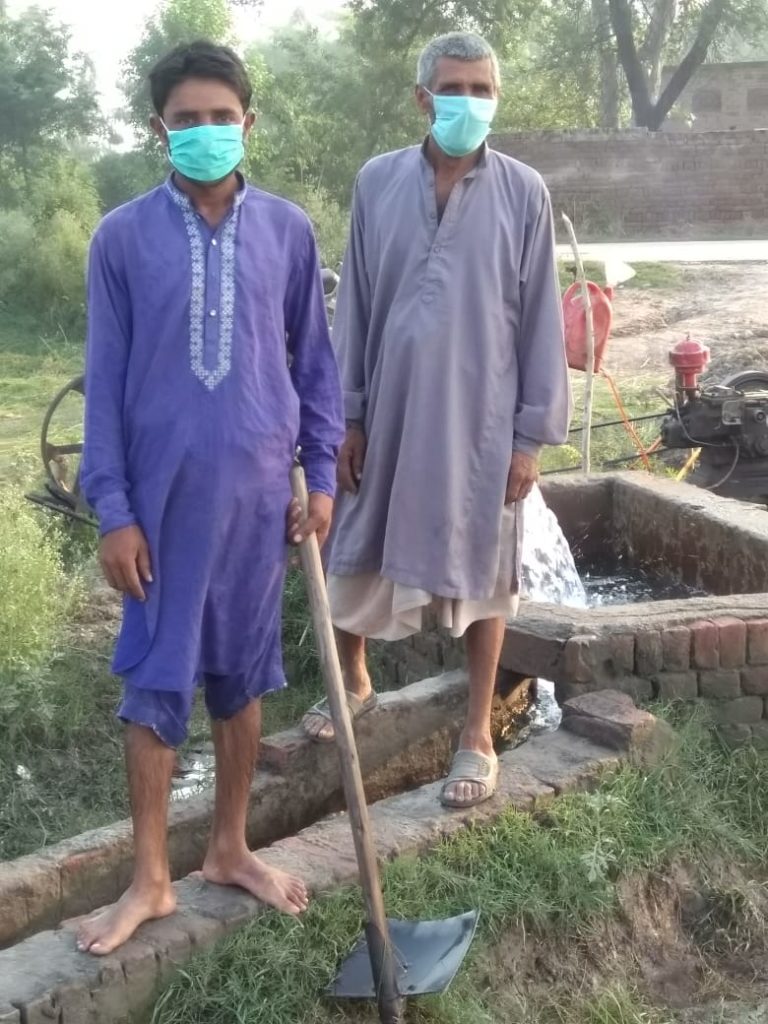
We excited to commence implementing operations supported by a grant and partnership with the International Fund for Agricultural Development (signed on the 28th of August – see our most recent quarterly report for more information) to support the digital extension activities in Kenya, Pakistan and – a new country for PAD – Nigeria.
We are also excited to be pursuing a new partnership with the Government of Brazil and the Inter-American Institute for Cooperation on Agriculture. This new opportunity will scale our digital extension work to farmers in a new hemisphere, on a new continent, and in a new geography, at a time when farmers’ informational needs continue to escalate, and in-person sources of information have become more tenuous.
Watch this space!
Otini Mpinganjira, Odisha State Lead, & Vineet Keshaw, Senior Implementation Associate, pay tribute to a remarkable team effort that has kept farmers informed in unprecedented times.
Precision Agriculture for Development’s Ama Krushi digital extension service was officially launched in 2018 with the ambitious target of reaching one million, predominantly poor, smallholder households in Odisha in just three years. Given the scale of the objective and the ambition of the delivery timeline, the culture of the Ama Krushi team is one that is accustomed to chasing down milestone achievements while adapting quickly to new challenges.
Generations of Odisha farmers have navigated challenges associated with drought and the cyclones that regularly rumble in off the Bay of Bengal. At the beginning of 2020, neither the Ama Krushi team nor the farmers we serve, could have anticipated the scale of the crisis associated with COVID-19, or the operational jiu-jitsu required of us to maintain – and grow – our digital extension service in the cross-hairs of the pandemic.
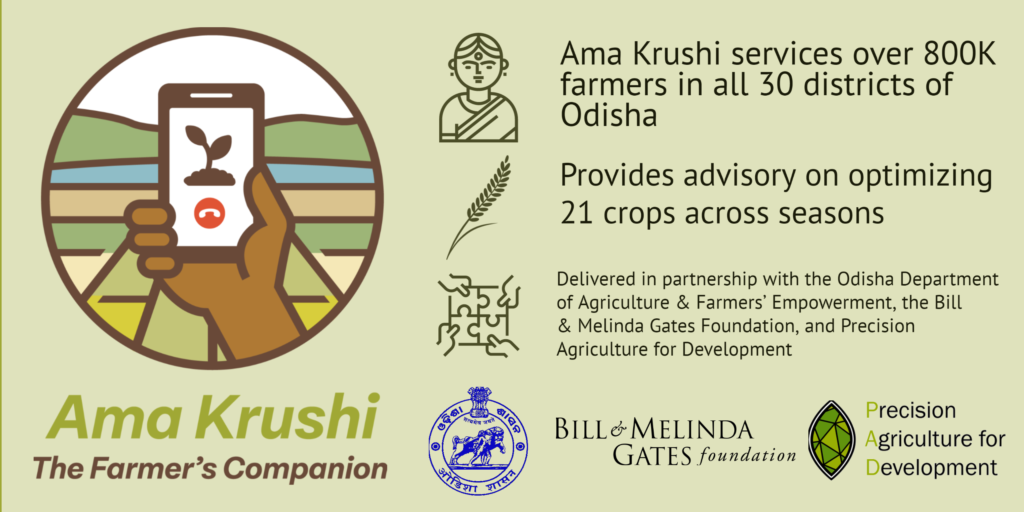
Two years along our delivery path, the two-way interactive voice response (IVR) system pioneered by Ama Krushi reaches over 800,000 farmers across all of Odisha’s districts. Our overarching task has always been clear: to deploy PAD’s iterative and human-centred approach to design, and to deliver actionable and impactful information to farmers via their mobile phones to secure and improve farmer livelihoods.
On a normal day (read: open office, no pandemic), a step into the programme office is welcomed with a buzz of activity akin to a lively bee colony: you hear the enthusiastic voices of approximately 100 call centre agents speaking to farmers handling a variety of tasks (onboarding new farmers, answering queries, coordinating remote training and remote surveying etc.). This buzz is contrasted by the soundproofed quiet of the content generation space with its pristine white walls and our team of agronomic experts going about their work responding to farmer queries or recording new messages.
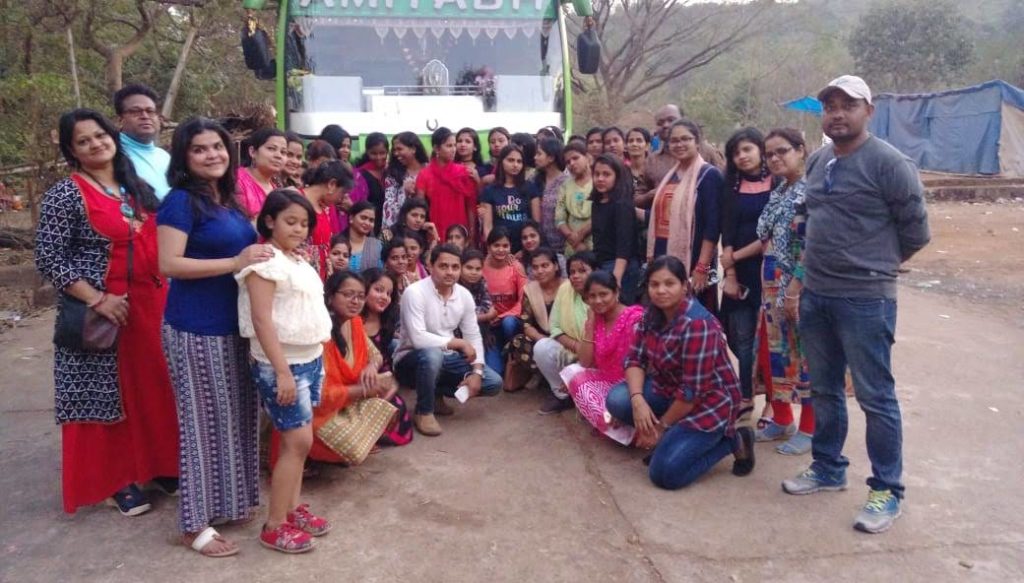
Aah, the good old days! As is now commonplace across the world, the situation today is very different to “normal”. However, one shouldn’t be too nostalgic. In normal circumstances, the smallholder farmers we serve face a level of information poverty that perpetuates a cycle of hunger and inhibits economic opportunity. By limiting physical interactions and affecting supply chains, the current pandemic has the potential to exacerbate this information gap; further escalating the precariousness of smallholder livelihoods.
PAD and the Ama Krushi team in Odisha have worked tirelessly to ensure minimal disruption to our services. Safety first!. Our highest priority was to ensure the safety of the team and our farmers. While the office was still open we swiftly implemented best practices to optimize hygiene, introduced a regime of regular disinfection for shared and commonly regularly used surfaces, provided hand cleansing facilities in all workspaces, and adjusted sick leave policies.
As the effects of the pandemic worsened and it became obvious that lockdown measures were imminent, the team worked to define a set of critical activities, and identified the complementary technologies and protocols that would be required to keep the programme operational as staff began working from home. Critical services and activities were identified as follows:
- Farmer Onboarding: Continued profiling and onboarding would ensure that new farmers could continue to join the service. In the context of the lockdown, onboarding farmers became more urgent as many farmers lost all other sources of information in the aftermath of agro-dealers being shut, and agricultural extension workers becoming unavailable due to the lockdown. The deep-dive in Box 2 below details the journey to moving our call centre operations to remote working status. Between April and June 2020, Ama Krushi successfully onboarded just over 106,000 new farmers.
- Content Delivery: Notwithstanding the well-documented advantages of digital extension services (cost-effectiveness, scalability, hugely favorable benefit-cost ratios, etc), a key advantage of digital advisory services during the current crisis is that information can be delivered via mobile phone without risking the health of farmers or extension workers. Delivering content would ensure that farmers registered on the service would continue to receive their weekly advisory messages. By happenstance, lockdown measures were imposed at an important transition point as farmers moved from harvest and crop storage activities following the winter season (Rabi), to preparation activities ahead of the summer season (Kharif). In addition to our regular agronomic advisory, Ama Krushi was well-placed to ensure that farmers were able to receive information alerts related to the lockdown. Overall, between April and June 2020, the service sent over 5.6 million outbound messages on a variety of topics (e.g. disease and pest management, harvest management, lockdown related advisories etc.).
- For example, on 15th & 16th April, Ama Krushi issued an advisory to ensure that farmers were aware that they could still take their produce to market (see Box 1, below)
- Similarly we distributed content related to the onset of the Kharif planting season, informing farmers that they could initiate cultivation.
BOX 1: Examples of messages sent during lockdown
“Namaskar. Welcome to Ama Krushi, the free Agriculture Information service of the Department of Agriculture, Government of Odisha. Some special information for farmers: Farmers who are harvesting a variety of vegetables this Rabi season can take their produce to the nearest agricultural market for sale. There is no barrier to transporting your products. Contact your nearest agricultural officer or horticultural officer for this.”
“Namaskar. Welcome to Ama Krushi […] Some special information for farmers: The current Kharif season has begun. At this time, farmers can cultivate their own land despite the coronavirus shutdown. You can use your own or rent agricultural machinery. Contact your nearest agricultural officer or horticultural officer for more information.”
- Farmer Helpdesk: We also needed to ensure the continued operation of our automated inbound service; i.e. to allow registered farmers to continue to call in and record questions 24/7. Our Live Call Centre (LCC) service, where farmers speak directly to an agent, saw a three hour extension in operating hours to assist farmers during a period of heightened need. Our partners at the Department of Agriculture & Farmers’ Empowerment (DAFE) actively promoted the LCC service through television and print media resulting in a 500% increase in traffic. For all inbound calls, our team applies tags which allow us to categorise the nature of a question and to link it to answer in our answer library. For lockdown operations, we introduced new tags to track issues related to the lockdown, as well as to ease the summarizing of data pertaining to the preparation of daily reports for DAFE and other policy makers. The team took the extra step of forwarding particularly complex queries to district nodal officers with the intention that they follow up with complementary advice in person on the ground. This was achieved in collaboration with members of the Analytics for Decision-making and Agriculture Policy Transformation (ADAPT) team; a sister project also working with DAFE. Between April and June 2020, the LCC received just over 24,000 calls primarily related to government schemes, market registration as well as pest and disease management.
- Research & Development: To more systematically understand the evolution of the pandemic and its local impacts, our research teams quickly developed a survey tool.
BOX 2: Moving a 100 person call centre to remote work
By design, the Odisha programme uses a call centre model to onboard (profile) farmers. The model has various advantages for data quality and resource effectiveness. In solving the problem of building remote call centre functionality, we borrowed heavily from tools under development in the technology pipeline. Over a 2 week period, we then worked to re-purpose them for the needed functionality. The main challenge was how to enable our agents to use a combination of feature-phones and smartphones to make and receive calls while maintaining some of the quality assurance protocols that we had in place. The other challenge was logistical; i.e. ensuring that agents had access to mobile phones and SIM cards, that we had an efficient and secure way of delivering farmer numbers and that we could train them on use of the new systems.
To test our solution, the team launched remote profiling at 25% of our operating capacity. At the same time, we introduced a back-check model to substitute our previous monitoring system. Our technical team made the requisite changes to ensure secure access to farmer’s details. The new home-based profiling system was not only customized to enable our staff to access it from their mobile phones, it also integrated a range of functions appropriated from the dialer system we use when working from the office, including the following additional functions:
- Sample selection: It automatically provides farmer details to survey agents.
- Call status: Survey agents are able to submit call status which helps to maintain the call log and the overall monitoring system.
- Incoming call: One of the biggest issues survey agents faced was not being able to record the details of farmers who call back. To assist with this challenge, we implemented changes to enable survey agents to profile and note the number of incoming calls.
- Survey agents activity: Surveyors can access their performance indicators, i.e. calls made, the number of farmers profiled over a month, a week and on that particular day.
- Training: To train our survey agents, we implemented a remote training solution utilizing video conferencing.
Given the scale of the challenges arrayed before us, and the emerging needs of our famers, we have of course experienced many challenges, including technology not functioning as intended to connectivity issues affecting output. We also continue to be engaged in a battle to shift our collective mindsets to maintain productivity as we work from home, and while we balance domestic duties and distractions.
As the Kharif season moves into gear and as we come to terms with the long-term nature of the pandemic, we have started to prepare more proactively for the future.
Normalisation is the key word here. Through downshifting, we are faced with the challenge of empowering execution staff to own – as they did before – the majority of day-to-day call centre functions. This will include training them on the tools that our project managers have been using to manage our remote call centre functionality as well as providing them with checklists and avenues for assistance. This will allow us to dedicate project management resources and capabilities to reintroducing deprioritised, but nevertheless important, components of the programme such as manual feedback surveys and remote farmer training.

We are immensely proud of the work of the Ama Krushi team. Through flexible application of technology, a get-stuff-done mentality, and the enduring spirit of this team, our service to farmers never stopped… Not even for a day.
From the survey agents and agronomists who showed their willingness to work from their home, despite many having to do so in circumstances that are far from ideal, to the supervising team who stayed on top of teething issues and provided valuable input when necessary. This has been a huge collective effort . An unavoidable cost of work-from-home arrangements is that not all jobs can be done from home. Similarly, some roles may become more peripheral as priorities are realigned. It has been heartwarming to note the care the team has extended toward one another. One example is the contributions drive organised towards a fund for our security guard, who due to mobility restrictions, was unable to return home to his family for several weeks.
As a team – spurred by a crisis or two – we have learnt the value of purposeful and early communication as a tool for establishing a common baseline understanding for everyone to work from, and the need for maintaining connections across the wider team. We have reaffirmed our shared mission to empower smallholder farmers, and despite not being together, we have worked together to keep the programme running.
We thank our partners at the Department of Agriculture and Farmers’ Empowerment for accommodating and supporting our work from home initiatives throughout this period.
Ama Krushi is on track to empower one million smallholder farming families ahead of schedule. None of us could have imagined the conditions in which we strive to reach that milestone, and pilot new projects targeting livestock and women farmers, as we continue to iterate and add more value to the service.

Sam Strimling, a Research Associate on PAD’s Kenya team, reflects on the results of an initial round of interviews surveying farmers and agro-dealers across Kenya’s agricultural heartland.
AGRO-DEALER & FARMER COVID-19 SURVEY, APRIL-JUNE 2020
Between late April and early June 2020, Precision Agriculture for Development (PAD) interviewed 973 crop farmers and 483 agro-dealers registered to the MoA-INFO SMS platform in Kenya. The results of the survey are intended to assist policymakers and the development community at-large to more accurately assess and respond to the impacts of COVID-19 on rural smallholder farmers and other actors across the agricultural value chain.
An overview of the results of this survey are summarized in this blog post. Please visit our organizational COVID-19 webpage to access survey instruments and background information, and to view a dashboard presenting global, and other country specific, insights from our survey data.
CONTEXT
The novel coronavirus, COVID-19, and associated public health mitigation measures — particularly stay-at-home orders and the closing of public spaces such as markets, schools and religious institutions — have had unique effects on poor rural populations in developing countries. In order to develop policies and interventions that effectively respond to the evolving impacts of the pandemic, policymakers require systematic and reliable data to understand the nature of challenges confronting actors across the agricultural value chain.
PAD is uniquely situated to source and analyse timely and accurate data from farmers and agro-dealers. Through our work with government and non-governmental organization (NGO) partners, our two-way digital advisory systems currently service 3.6 million farmers in eight countries. As a matter of course, we collect and disseminate information to empower farmers to adopt behaviour changes that improve productivity and their livelihoods. This blog post summarizes the results of an initial survey of smallholder farmers and agro-dealers administered through the MoA-INFO service in Kenya.
BACKGROUND
In 2018, PAD launched MoA-INFO, a free two-way SMS platform developed in collaboration with the Kenyan Ministry of Agriculture. The impetus for the service arose in response to a national crisis stemming from a novel and rapidly-spreading invasive pest, the Fall Armyworm (FAW). An import from the Americas, FAW decimated African crops, with disproportionately dire impacts for maize farmers — a staple crop and critical source of nutrition in many sub-Saharan African communities.
Today, through a combination of push messages, menu-based content, and interactive decision-support tools, MoA-INFO provides actionable information to farmers to optimize the cultivation of eight crops (maize, beans, potatoes, sweet potatoes, pigeon peas, bananas, tomatoes, and sorghum) in addition to its foundational advisory content relating to how to monitor and address FAW infestation. Farmers rely on agro-dealers to purchase inputs (seed, fertilizer, pesticide, etc.), but also rely on these traders as a source of advice and repository of expertise. As the service matured, agro-dealers have been recruited to the platform to better inform them about farming best practices and the optimal use of inputs so that they can better service their customers.
At present, approximately 367,000 farmers and 1,246 agro-dealers are registered on the MoA-INFO service across all of Kenya’s 47 counties. Given PAD’s ongoing engagement with farmers and agro-dealers via the platform, we are well-placed to survey and interpret data sourced from smallholder and agro-dealer populations which other NGOs and policymakers may have more limited access to.
SAMPLE CHARACTERISTICS
Between April 29 and June 2, PAD interviewed 973 crop farmers and 483 agro-dealers. Interviews of farmers and agro-dealers covered 44 and 40 counties, respectively. The farmers interviewed were 58% male, 41 years old on average, and 79% grew maize as their primary crop. The agro-dealers interviewed owned Small to Mid-size Enterprises (SMEs), employing an average of two employees and averaging 1.3 million Kenyan Shillings (KSH – approximately US$12,000) in annual sales.
FINDINGS
A COVID-related challenge confronting farmers in Kenya is a reported reduction in working hours on the part of many agro-dealers. While only 3% of surveyed agro-dealers reported closing their stores entirely, a majority (65%) of agro-dealers reported closing between 4-6pm in the seven days prior to being surveyed, earlier than the typical closing hours of 6-8pm.
Decisions to close early may be partially attributable to the Kenyan Government’s 7pm-5am nationwide curfew, which was in place while the survey was in the field. However, 80% of agro-dealers reported an overall decrease in footfall, and 76% reported lower sales relative to the same month last year; this suggests that agro-dealers have not been able to condense their regular operations into fewer hours.
Furthermore, 62% of agro-dealers interviewed reported that they expect future footfall to continue to be low, and the same number reported low expectations for future sales. Typically, agro-dealers report the highest volume of sales during February and August, when farmers buy their inputs to coincide with the planting schedule for Kenya’s long and short rain seasons, respectively. We hope that future surveys will be able to assess the extent to which the expectations reported by agro-dealers in this round are borne out.
The most common reason for diminished farmer footfall offered by agro-dealers — cited by 81% of agro-dealers interviewed — was that farmers had insufficient resources to purchase inputs. Agro-dealers have tried to address this perceived constraint on business by extending credit to trusted farmers. Fifty-four percent of farmers surveyed reported increased prices being charged by suppliers and, in turn, 47% reported having to increase the prices they charged to farmers.
Increases in input prices are corroborated by farmers: of the 35% who purchased fertilizer, 44% reported price increases, and of the 19% who reported purchasing pesticides, 50% reported a price increase. While only 6% of farmers purchased seeds, 58% of these farmers reported price increases.
Reported price increases were not limited to inputs: 83% of farmers interviewed reported an increase in the price of maize. While price increases are not uncommon at this time of year (the ‘lean season’), the reported effect was particularly dramatic: 86% of farmers reported difficulties buying food due to market changes, and 46% reported having to reduce the size or number of household meals. Moreover, 75% of farmers interviewed reported having to eat into savings, and 55% reported borrowing money in the last 30 days, to cover living expenses. These patterns of reported dis-saving and borrowing may limit farmers’ investment budgets and demand for inputs in the next agricultural season. Moreover, these trends may be further compounded by disruptions to the labor market in the agricultural sector: 33% of farmers reported hiring workers for fewer days to do work on their farm than at the same time last year, and 29% reported working fewer days on others’ farms.
Female crop farmers reported greater food insecurity than their male counterparts across several measures: compared to male farmers, female crop farmers reported that household members reported spending fewer days on their own farms and paying higher prices for fertilizer. Female crop farmers were also significantly more likely than their male counterparts to report that they had had to rely on assistance from family to cover living expenses and having to reduce the size or number of meals served in the 30 days prior to being surveyed.
To inform a better understanding of the persistent effect of COVID-19 on food security, including potential differential effects by gender, we plan to interview farmers over time to monitor changes in staple food prices (relative to the same time the previous year). PAD will commence a second round of surveys in July to monitor how the situation evolves, and to assess shifts in reported welfare and expectations associated with a relaxation or termination of restrictions on movement.
In good news, farmers seemed optimistic about their forthcoming harvests: 52% of farmers interviewed reported that they expect a more bountiful harvest than they did in the previous year; 66% reported that they expect to sell their produce in the market at a higher price; and just 14% reported that they expect not to be able to sell part of their harvest. Farmers indicated that expectations of improved harvests were premised on improved rainfall, as well as higher observed market prices, which led farmers to expect higher prices for future harvests. A majority of farmers (86%) reported having storage space which may enable them to more readily withstand potential market disruptions.
Agro-dealers continue to look for ways to best serve farmers, and adapt to an adverse business environment, with 29% reporting that they had implemented changes to sales. Of the subset of farmers who said they had made such changes, 21% reported allowing farmers to pay for inputs using mobile money. While payment via M-PESA – the mobile money platform operated by Kenya’s largest mobile network provider – had been common throughout Kenya prior to the outbreak of COVID-19, these agro-dealers specifically mentioned instituting these transactions as a means of adapting to the pandemic. Overall, 62% of agro-dealers reported changes in operations due to COVID-19, the two most commonly reported were availing farmers of hand washing options (50%) and encouraging mask use (34%). Moreover, while 26% of agro-dealers stated they were unable to purchase inputs from suppliers – and a majority of these agro-dealers (58%) attributed this difficulty to constrained supply of inputs – many reported making changes to how they stock inputs in order to meet farmers demand. Reported changes included using mobile money when transacting with suppliers, and changing the quantity, time frame, or delivery method for orders. Overall, just over a quarter of agro-dealers (27%) reported that they foresee being unable to meet farmer demand.
While both farmers and agro-dealers have encountered economic challenges related to COVID-19, there nonetheless appears to be broad agreement that, from a public health standpoint, government measures constitute the right course of action: 76% of farmers assessed government actions as “very effective” or “somewhat effective” in mitigating the spread of the virus. Seventy-three percent of agro-dealers and 67% of farmers said that they feared contracting the virus, and 33% of agro-dealers named loss of wage income as a concern.
RECOMMENDATIONS
Taken together, the data collected so far suggest several potential strategies to insulate smallholder populations and agricultural value chains that rely on smallholder productivity from potentially damaging impacts associated with COVID-19. While many farmers remain optimistic about future harvests, there are signs of input market disruptions and increasingly stressed household consumption.
Providing cash transfers and social assistance to smallholder populations will help to insulate poor farming households from the effects of increased market prices for maize flour and other foodstuffs, and help to sustain demand for agricultural inputs to support the forthcoming planting cycle. On May 12, the Indian government released a relief package valued at approximately US$265 billion, which combines targeted financial support (including loans, cash transfers, and wage increases) with direct provision of agricultural staples (i.e., wheat, rice, and pulses) at the individual and household level. A similar package would likely go a long way toward relieving the financial distress and consumption difficulties faced by Kenyan farmers.
Farmers reported strong demand for digital information relating to the pandemic: 88% of farmers surveyed reported an interest in receiving digital updates related to COVID-19. Of those interested, 74% requested public health advisory content, 47% requested news-style updates relating to the progress of the pandemic (cases, recoveries, etc.), and 34% requested updates about pandemic-related government policies and actions.
Overall, 98% of agro-dealers reported communicating with suppliers via mobile phone, and 70% reported receiving messages from farmers about inputs at least once a day. By establishing formal channels across the value chain, farmers can communicate their needs and preferences. Better informed agro-dealers may be better positioned to overcome challenges to meeting farmer demand — for example through communicating farmer requests to suppliers, thus ensuring that needed inputs are available. Additionally, enabling agro-dealers to efficiently communicate with local suppliers to gather information on input availability and prices could help them procure inputs on time. Finally, such a channel would assist agro-dealers in implementing changes to how they stock, which about one-third have already reported adopting, including using cashless transactions and having inputs delivered.
CONCLUSION
As part of the World Bank’s One Million Farmers initiative, PAD is working with 14 start-ups across Kenya which collectively are working to deploy digital technologies toward improving market linkages, input delivery, and provision of crop insurance, credit, and extension advice. At an organizational level, we hope to use the information collected here to more effectively design and implement a service that will empower smallholder farmers and agro-dealers with information to more effectively mitigate challenges associated with this unprecedented disruption to the supply chain.
PAD’s theory of change is based around evidence that well-sourced, timely and actionable information can empower farmers and policy-makers to act in the world to improve lives and secure livelihoods. This theory is core to the design and implementation of the services we deliver across all of our projects globally. Sourcing opinions and data from farmers to more accurately understand their challenges and aspirations is critical for delivering timely information for practical application in farmers’ fields and households. The information collated through this survey and similar surveys in other geographies is intended to contribute to the evidence base in a rapidly shifting context with new and ill-defined challenges. We welcome your feedback and interest in partnering with us as we iterate our work.
This blog post was updated on 07.06.20 to include new gender-related insights

How does one empower smallholder farmers during the COVID-19 pandemic? Jonathan Lehe – PAD’s Chief Development Officer and Director of New Programs – reflects on the powerful advantages of digital information systems in a context of crisis, and how acting now will lay a foundation for future development.
Before the COVID-19 pandemic brought the world to its knees, I was eagerly awaiting the 12th ICT4D Conference which had been scheduled to take place in Abuja, Nigeria in April. As with so many aspects of our lives that we have had to adjust to protect ourselves and our communities from this virus, the ICT4D Conference had to adjust, and went virtual.
As part of the virtual conference, I had the pleasure of participating in a webinar on the topic “Supporting Farmers with Low-Cost Digital Tools During COVID-19” where I spoke about the work PAD is doing to support smallholder farmers during the pandemic. The webinar turned out to be a great success, and unwittingly demonstrated how digital technology can provide innovative solutions to overcome some of the adverse effects of this crisis, and showcased how digital channels can make information accessible to a wider audience, far beyond the lucky few who would have been reached in person.
Smallholder farmers are among the most vulnerable populations in the world, and are particularly vulnerable to negative shocks associated with this pandemic. We believe that digital information services are particularly well-placed to help farmers respond to the pandemic, for several reasons. Digital services:
- do not require face-to-face contact with farmers, and can be maintained at a time when in-person services are impossible;
- are highly scalable – PAD’s services reach 3.6 million farmers in eight countries around the world;
- are cost-effective – PAD’s advisory services cost just $1.55 per farmer per year, on average;
- are available on demand;
- democratize access to information – reaching farmers with the simplest feature phones, no data coverage, and limited digital literacy, and those in many hard-to-reach, fragile, or conflict-affected settings which traditional extension cannot reach;
- enable two-way communication, so we can gather real-time data from farmers;
- can be highly customized and tailored to users’ needs; and
- can be continuously iterated and improved in real-time.
These features are particularly valuable in an emergency situation when conditions on the ground change rapidly.
To respond to COVID-19, PAD is adapting and broadening our digital information services to meet farmers’ evolving needs:
In Kenya, where traditional extension has been completely disrupted, our MOA-INFO platform, which we implement in collaboration with the Ministry of Agriculture, remains fully available to the 360,000 farmers it serves, and is expanding to include advisory content on three new crops. This platform was originally designed to respond to a different emergency – the Fall Armyworm outbreak which ravaged Africa in 2018 – and from its inception was designed to facilitate a two-way flow of information and adapt rapidly to farmers’ needs.
In Uganda, where PAD is conducting research comparing in-person and digital extension in partnership with TechnoServe and HRNS, in-person training has been halted entirely due to strict social distancing protocols. Unaffected by restrictions on human movement, PAD has stepped in to provide comprehensive digital advice to smallholder coffee farmers. We have also adapted our service to provide COVID-19 advisory content based on the Ministry of Health’s official recommendations, including a description of common symptoms, how to avoid spreading the virus, and how to get additional information.
In India, while traditional extension has been suspended, PAD’s digital services have remained open, and continue to serve 830,000 farmers across six states, while adding thousands of new farmers to the platform each month. In addition to our existing services we are expanding our advisory content to address several critical new information gaps in response to COVID-related market disruptions. In many cases, we collect crowd-sourced information from farmers, triangulate this information using multiple farmer data sources, validate it with a subset of farmers to ensure its accuracy, and inform farmers about its source when we disseminate it. Crowd-sourced information about which markets remained open, which crops are sold on what days and at what prices, and which agricultural activities are exempt from lockdowns may change from day to day, so having access to real-time information can be enormously useful to farmers. Other types of new content include how to produce organic inputs while markets are inaccessible, and how to store crops that cannot be sold at markets.
In a crisis like this, gathering systematic and reliable data on challenges confronting rural populations can be difficult. PAD has built and maintains a large user database of farmers spanning eight geographies on two continents. This provides us with real-time feedback we can use to rapidly understand and respond to shifting needs as the pandemic evolves.
PAD is conducting a multi-country phone survey of farmers, agro-dealers, and extension workers in Kenya, India, Pakistan, and Uganda to rigorously understand the pandemic’s impact. We are collecting data on a wide range of agricultural market disruptions, including farmers’ access to input and output markets, food security, price changes, income loss, migration, and other adverse events. We are also collecting health-related data, including farmers’ knowledge and perception of public health messages, and adherence to recommended behaviors such as hand washing and social distancing.
Looking ahead, PAD is working on several new digital tools that can be rapidly deployed to help farmers respond to market disruptions. Building trust with our users during more normal times enables us to quickly adapt and provide valuable new services. For example, we are creating a vetted database of agro-dealers and output buyers, and connecting farmers with these intermediaries so that key services are not interrupted. As mentioned above, we are aggregating and disseminating crowd-sourced market information to farmers, including crop prices which are fluctuating more than usual. We are also expanding our services to include COVID-specific health information, such as disseminating public health campaigns on hand washing and social distancing. User-centered design and A/B testing, which are deeply embedded in our services, are especially valuable in this rapidly changing context. For example, A/B testing can be used to rigorously determine the optimal way to deliver public health messages to maximize their influence for changing behavior among rural populations.
Digital agricultural extension is a scalable, cost-effective solution that helps more farmers access actionable information. Digital tools are an important complement to traditional extension services even when in-person extension is available. In an emergency context, when traditional in-person communication channels are impossible, investing in low-cost digital tools to get farmers the information and market linkages they need, to gather real-time information on the challenges on the ground, and to adapt these tools to address these new challenges become urgent priorities. Just as the ICT4D webinar provided me with an opportunity for open dialogue with hundreds of development practitioners across dozens of countries without having to leave my living room, digital agricultural extension is already helping millions of farmers around the world access the best agricultural expertise and advice from the palm of their hand. Investing in digital agriculture now will not only empower farmers to weather the COVID storm in the short term by supporting farmers’ livelihoods and food security, it will also accelerate the long-term transformation of agricultural extension systems and lay the foundation for advances in rural development long into the future.
The impact of the novel coronavirus, COVID-19, is changing the lives of our staff and the farmers we serve across all our geographies. Our families, community and colleagues have not escaped the most pernicious effects of the virus, and we hold those affected in our thoughts as they deal with loss, social distance from family, closure and healing. People are scared about health and livelihoods, for themselves and for other people: we hear you, and we will do everything we can to be there for you.
PAD’s approach to digital development has proven to be resilient, adaptable and capable of helping farmers in contexts where traditional in-person extension services are not possible because of the need to maintain social distancing. As well as expanding our suite of digital extension services we are providing tools to help our partners collect information from farmers to improve understanding of the evolving impacts of COVID-19 on smallholder populations and food security and inform evidence-based decision-making on the part of policymakers.
We have adapted rapidly to mitigate the impact of social distancing protocols on the ways we work. We have adapted our two-way farmer communication flows to make greater use of inbound information from farmers, in order to better understand the COVID-19-related needs and knowledge of smallholder populations, and to advance efforts to slow and analyze impacts associated with the virus. In addition, we are beginning to explore approaches to mitigate the particular challenges posed by the pandemic for smallholder farmers, such as disruptions to agricultural input supply chains and curtailed access to markets for selling farm produce.
From an operational perspective, we decided as an organisation to transition all staff to work-from-home arrangements before official lockdown decisions were implemented across all our geographies, and were able to repatriate a majority of staff who chose to return to their home countries and cities before travel restrictions prevented such movement. We are fortunate and thankful that our staff were largely able to avoid logistical quagmires.
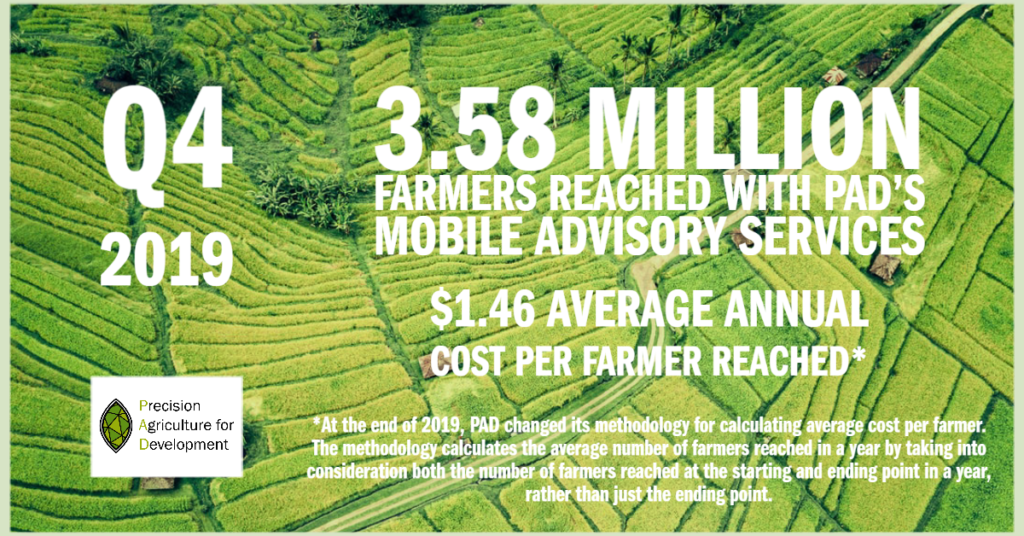
This quarter we were able to continue to modestly expand our farmer reach, despite challenges posed by the pandemic, and seasonal downturns in production among some of our largest groups of farmers.
A detailed presentation of the digital capabilities PAD can deploy in response to COVID-19 is accessible here. Information relating to current COVID-related research and learning are presented in our Quarterly Report. Updated research, findings and pandemic-response activities will be posted to our COVID-19 page and to this blog.
Please take care,

OWEN BARDER
Chief Executive Officer
Make an Impact Today


